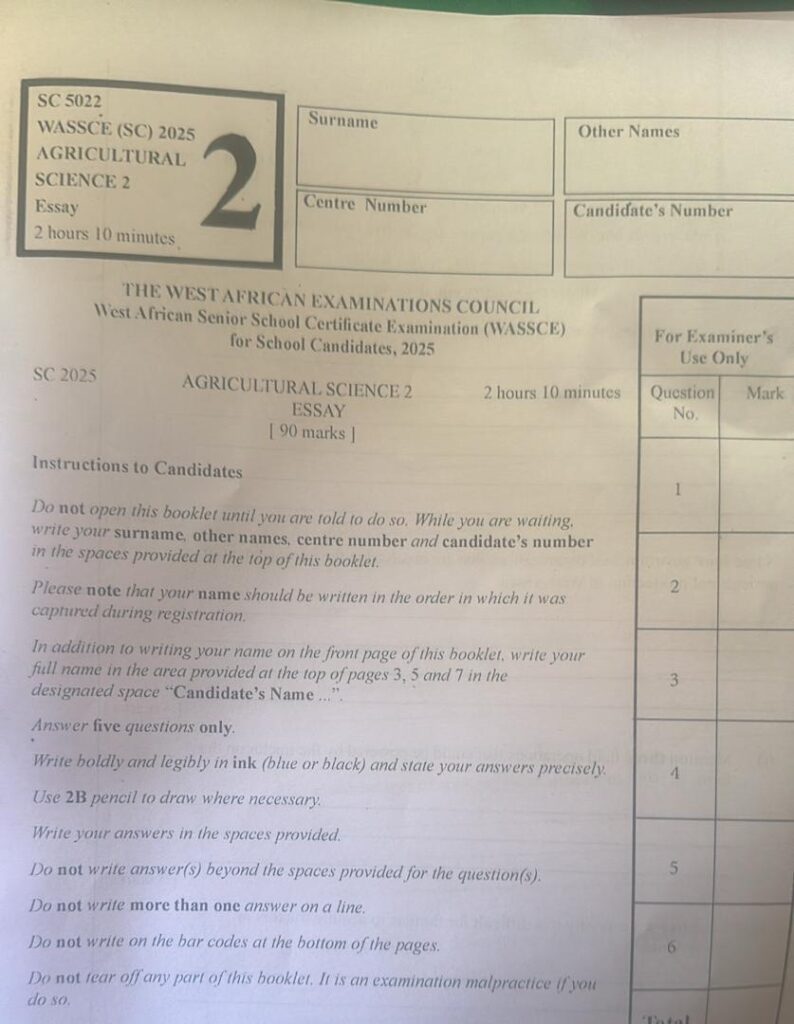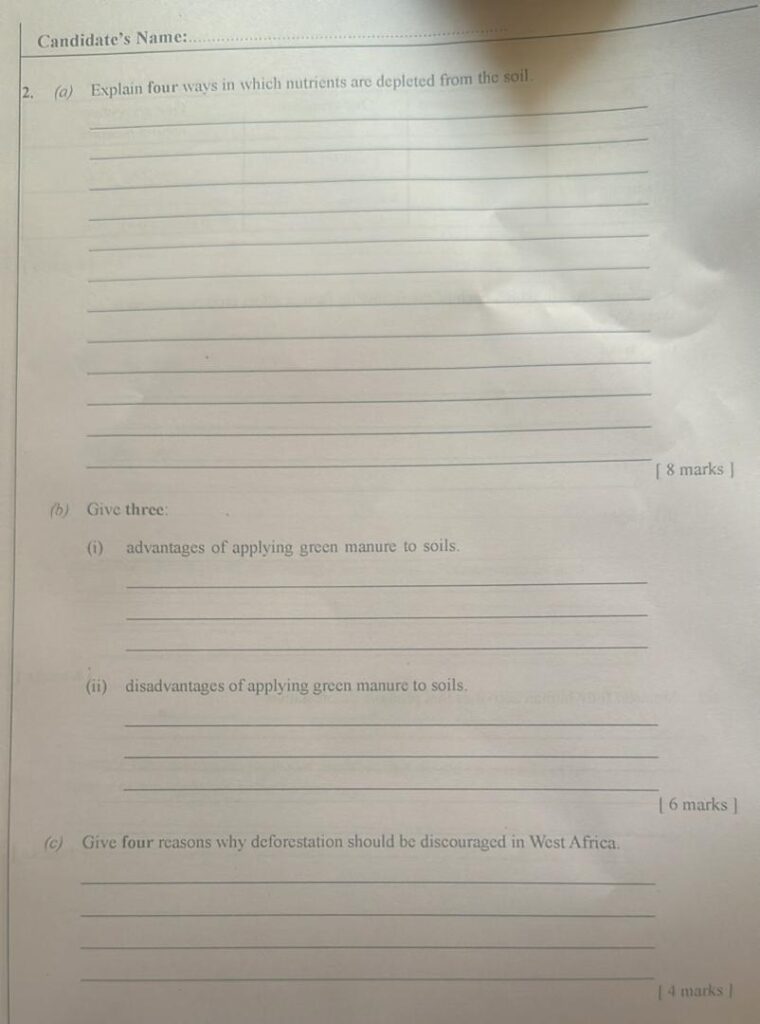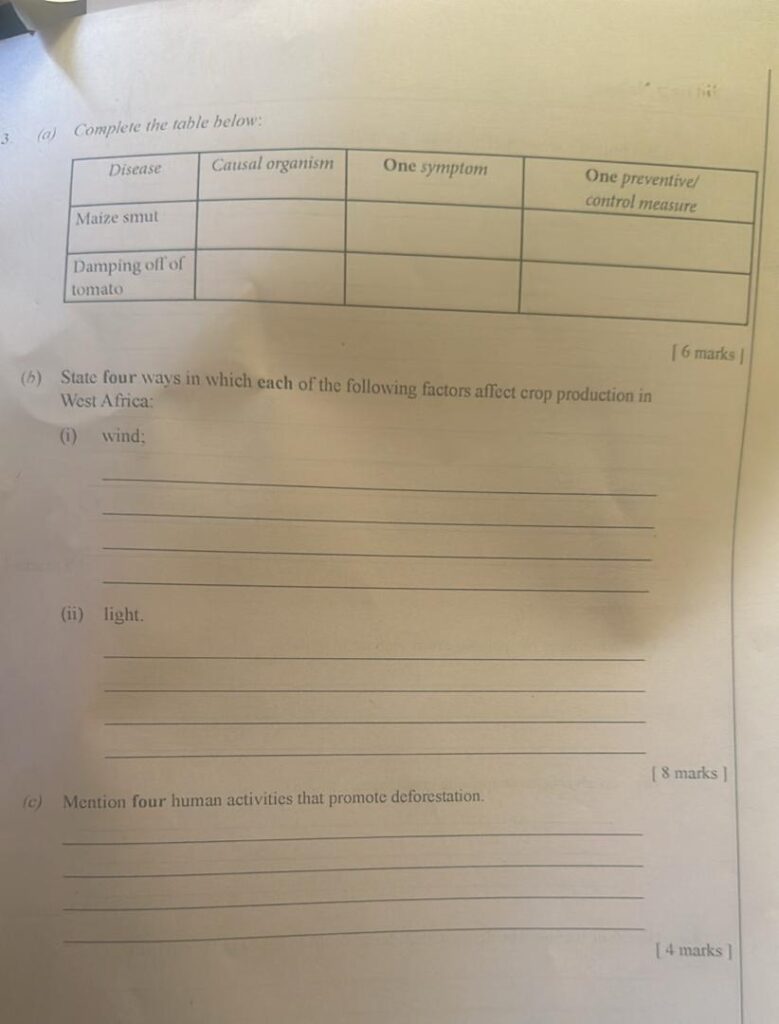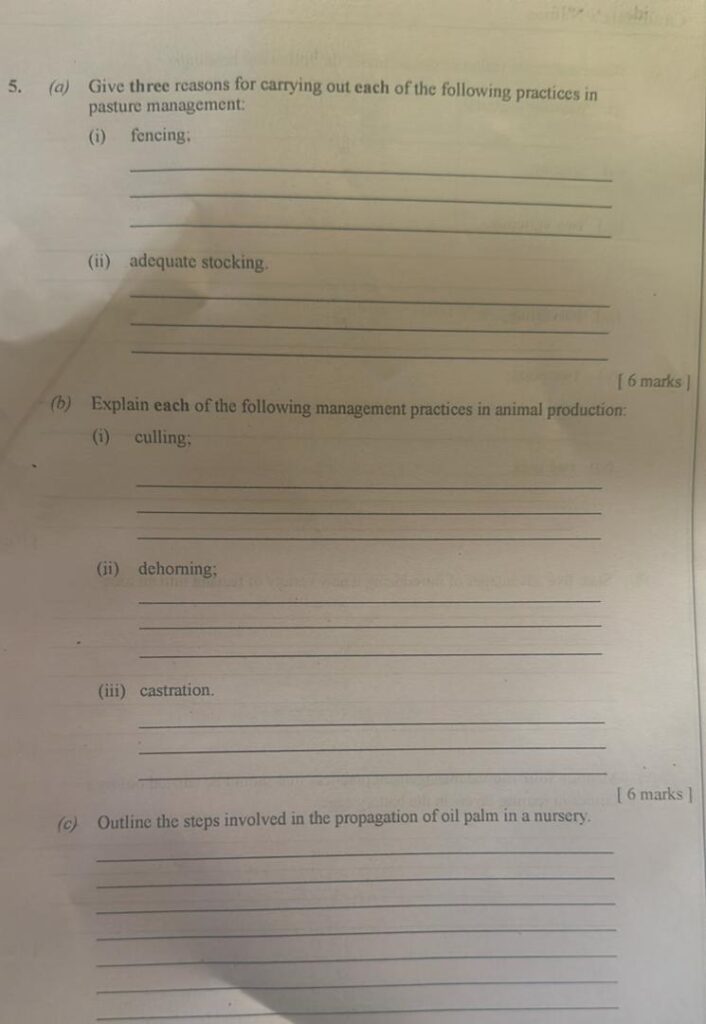WAEC Agricultural Science OBJ 2025
1-10: CABDBDDABC
11-20: DABABACBDB
21-30: BCCACABBDC
31-40: BCDACBDCBD
41-50: DCCACBBCAD
WAEC Agricultural Science Essay 2025
Number 1
(1a)
(PICK ANY SIX)
(i) Climate change
(ii) Poor agricultural practices
(iii) Soil degradation
(iv) Inadequate infrastructure
(v) Political instability
(vi) Conflict and insecurity
(vii) Economic challenges
(viii) Poor access to markets
(ix) Population growth
(x) Pest and disease outbreaks
(1bi)
(PICK ANY FOUR)
(i) West African Agricultural Productivity Program (WAAPP)
(ii) Economic Community of West African States (ECOWAS)
(iii) African Development Bank (AfDB)
(iv) National Agricultural Research Institutes
(v) National Agricultural Extension and Research Liaison Services (NAERLS)
(vi) River Basin Development Authorities
(vii) National Agricultural Land Development Authority (NALDA)
(1ci)
(PICK ANY THREE)
(i) Plowing
(ii) Harrowing
(iii) Planting
(iv) Irrigating
(v) Fertilizing
(vi) Spraying pesticides and herbicides
(vii) Cultivating
(viii) Harvesting
(ix) Tilling
(1cii)
(PICK ANY FIVE)
(i) High cost of tractors
(ii) Limited access to credit
(iii) Inadequate financing options
(iv) Lack of tractor maintenance services
(v) Poor road infrastructure
(vi) Limited awareness of tractor benefits
(vii) Insufficient government support
(viii) Small farm sizes
(ix) Lack of proper training
(x) Cultural and traditional farming practices
==================
Number 2
(2a)
(PICK ANY FOUR)
(i)Crop Harvesting: When crops are harvested, the nutrients they absorbed from the soil are removed, leading to nutrient depletion.
(ii)Leaching: Excess water can leach nutrients out of the soil, making them unavailable to plants.
(iii)Erosion: Soil erosion, whether through water or wind, can lead to the loss of topsoil and essential nutrients.
(iv)Over-Fertilization: Overuse or improper use of fertilizers can lead to soil degradation and nutrient imbalances.
(v)Continuous Cropping: Planting the same crop repeatedly without rotation can deplete specific nutrients from the soil.
(vi)Soil Degradation: Loss of organic matter, structure, or biodiversity can reduce soil fertility and lead to nutrient depletion.
(vii)Runoff: Surface water runoff can carry away nutrients, reducing soil fertility and affecting water quality.
(viii)Volatilization: Certain nutrients, such as nitrogen, can be lost to the atmosphere as gases, reducing their availability to plants.
(2bi)
Advantages of Applying Green Manure to Soils:
(PICK ANY THREE)
(i)Green manure adds nutrients to the soil.
(ii) Green manure increases soil organic matter, structure, and fertility.
(iii) Some green manure crops can suppress weed growth.
(iv) Green manure crops help hold soil in place, reducing erosion.
(v)Green manure promotes beneficial microbial activity.
(2bii)
Disadvantages of Applying Green Manure to Soils:
(i) Planting and incorporating green manure requires extra labor.
(ii)Green manure crops may compete with main crops for resources.
(iii)Seeds and labor costs for green manure can be high.
(iv)Green manure crops can harbor pests or diseases.
(v) Timing of green manure incorporation can be critical.
(2c)
(PICK ANY FOUR)
(i)Deforestation can lead to loss of biodiversity.
(ii)Deforestation exacerbates climate change.
(iii)Deforestation causes soil erosion.
(iv)Deforestation disrupts the water cycle.
(v)Deforestation displaces indigenous communities.
(vi)Deforestation has negative economic consequences.
(vii)Deforestation increases greenhouse gas emissions.
(viii)Deforestation reduces livelihood opportunities.
==================
Number 3
Answers Loading…
==================
Number 4
(4ai)
Seed.
(4aii)
75–90 cm between rows and 30–45 cm between plants.
(4aiii)
(PICK ANY TWO)
(i) SAMCOT 9
(ii) SAMCOT 10
(iii) SAMCOT 11
(iv) SAMCOT 12
(v) BT Cotton
(vi) Desi cotton
(4aiv)
Hand-picked or mechanically harvested when bolls are fully open and dry.
(4av)
(PICK ANY TWO)
(i) bollworms
(ii) aphids
(iii) whiteflies
(iv) Cotton stainers
(4avi)
(PICK ANY TWO)
(i) Spun into yarn for making clothes, fabrics, and textiles.
(ii) Used for extracting cottonseed oil, which is edible and used in cooking.
(iii) A by-product used as animal feed.
(iv) The short fiber left on seeds after ginning is used in paper and film production.
(v) Cotton is also used in medical supplies, padding, and insulation.
(4b)
(PICK ANY FIVE)
(i) It brings about higher yield
(ii) It facilities disease and pest resistance
(iii) It produces better fruit quality
(iv) Climate adaptability
(v) It has economic benefits
(vi) It improves nutrition
(vii) It fosters market expansion
(4c)
(PICK ANY FOUR)
(i) Provide balanced layer feed regularly to ensure good egg production.
(ii) Supply clean, fresh water at all times.
(iii) Collect eggs at least 2–3 times daily to avoid breakage and maintain cleanliness.
(iv) Regularly clean cages, feeders, and drinkers to prevent disease.
(v) Observe birds daily for signs of illness and isolate sick ones.
(vi) Follow a proper vaccination schedule and treat diseases promptly.
(vii) Remove droppings frequently to reduce ammonia buildup and odor.
(viii) Maintain appropriate lighting (14–16 hours/day) to stimulate egg laying.
(ix) Keep accurate records of feed intake, egg production, mortality, and medication.
(x) Control rodents, flies, and other pests around the cages.
==================
Number 5
(5ai)
-Fencing-
(PICK ANY THREE)
(i) Prevents animals from straying or escaping.
(ii) Protects pasture from overgrazing by controlling access.
(iii) Prevents theft or loss of livestock.
(iv) Keeps out predators and trespassers.
(v) Helps in rotational grazing by dividing the land into paddocks.
(vi) Protects young or newly established pasture from being grazed prematurely.
(5aii)
-Adequate stocking-
(PICK ANY THREE)
(i) Prevents overgrazing and degradation of pasture.
(ii) Ensures animals get enough feed and maintain good health.
(iii) Maintains soil fertility and reduces erosion.
(iv) Enhances uniform utilization of pasture.
(v) Promotes regrowth of pasture grasses.
(vi) Helps in better planning and management of farm resources.
(5bi)
Culling: This is the process of removing unproductive, sick, or undesirable animals from a herd or flock to improve the overall quality and productivity.
(5bii)
Dehorning: Dehorning is the removal of horns from animals (especially cattle and goats) to prevent injuries to other animals and handlers and to reduce space requirements in housing and transport.
(5biii)
Castration: Castration is the removal or inactivation of the testes in male animals to prevent breeding, reduce aggression, and improve the quality of meat.
(5c)
(i) Seed selection
(ii) Pre-germination
(iii) Sowing
(iv) Watering
(v) Shading
(vi) Weeding and pest control
(vii) Transplanting
—————————————-
Number 6
(6ai)
Farm Inventory:
(PICK ANY ONE)
-Farm inventory refers to a detailed list of all the assets, resources, and materials available on a farm, including equipment, livestock, seeds, fertilizers, and other inputs.
-Farm inventory is the process of counting, valuing, and recording all the physical assets and resources on a farm to determine their quantity, quality, and value.
(6aii)
Depreciation:
(PICK ANY ONE)
-Depreciation is the decrease in value of a farm asset over time due to wear and tear, obsolescence, or other factors, which reduces its useful life and value.
-Depreciation is an accounting method that allocates the cost of a farm asset over its useful life, allowing farmers to claim a tax deduction for the asset’s decline in value.
(6aiii)
Liability:
(PICK ANY ONE)
-Liability in farm management refers to a debt or financial obligation that a farm business owes to others, such as loans, accounts payable, or mortgages.
-Liability can also refer to a farm’s legal responsibility for damages or injuries caused to people or property, such as liability for accidents or environmental damage.
(6aiv)
Salvage Value:
(PICK ANY ONE)
-Salvage value is the estimated value of a farm asset at the end of its useful life, which can be sold or repurposed and is often used to calculate depreciation.
-Salvage value represents the residual value of a farm asset after it has been fully depreciated and can be used to offset the cost of replacing the asset.
(6bi)
(PICK ANY ONE)
-The law of supply states that, all other factors being equal, the quantity of a good supplied increases as the market price increases and decreases as the market price decreases.
-The Law of Supply states that as the price of goods or services increases, the quantity supplied also increases. Conversely, as the price decreases, the quantity supplied decreases.
(6bii)
(PICK ANY THREE)
(i)Weather conditions
(ii)Price of inputs
(iii)Technology
(iv)Government policies
(v)Diseases and pests
(vi)Climate change
(vii)Availability of credit and finance
(viii)Seasonality and harvest cycles
(6c)
(PICK ANY FIVE)
(i)Some weeds can be toxic to animals if ingested.
(ii)Certain weeds can cause allergic reactions in animals.
(iii)Weeds can cause digestive problems if eaten.
(iv) Weeds can contaminate animal feed.
(v)Some weeds can be poisonous if ingested in large quantities.
(vi) Certain weeds can cause skin sensitivity.
(vii)Some weeds can affect animal reproduction.
(viii) Weeds can displace nutritious plants in pastures.
(ix)Weeds can lead to health issues.
(x) Weeds can impact animal growth and productivity.









I need midnight answer everyday please
Please it’s always taking time before you send the answers
Thanks for the answers
When is agricultural science answer dropping???
I need agric answers now
Please keep me updated every night
Keep me updated every night
Good job 👏👏👏 on Tuesday 😺💪💪💪💪💪💪💪💪💪💪💪
I need midnight answers everyday please
I need answer during the day
Plz when are they sending this government
Plz I need agriculture question